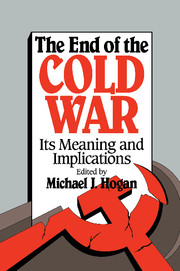Book contents
- Frontmatter
- Contents
- Preface
- The Authors
- Dedication
- 1 Introduction
- 2 An End to Which Cold War?
- 3 The Cold War, the Long Peace, and the Future
- 4 Quiet Cataclysm: Some Afterthoughts on World War III
- 5 Some Lessons from the Cold War
- 6 Nuclear Weapons and European Security during the Cold War
- 7 Victory in the Postwar Era: Despite the Cold War or Because of It?
- 8 The Wicked Witch of the West is Dead. Long Live the Wicked Witch of the East
- 9 The End and the Begining
- 10 A Balance Sheet: Lippmann, Kennan, and the Cold War
- 11 Why Did the Cold War Arise, and Why Did It End?
- 12 A View from Below
- 13 The End of the Cold War and the Middle East
- 14 The End of the Cold War in the Near East: What It Means for Historians and Policy Planners
- 15 After the Cold War: The United States, Germany, and European Security
- 16 The End of the Cold War: A Skeptical View
- 17 The End of the Cold War, the New Role for Europe, and the Decline of the United States
- 18 The Fading of the Cold War—and the Demystification of Twentieth-Century Issues
- 19 The U.S. Government, a Legacy of the Cold War
- 20 Foreign Policy, Partisan Politics, and the End of the Cold War
- 21 Beyond Bipolarity in Space and Time
- 22 A Usable Past for the Future
- Selective Bibliography
- Index
5 - Some Lessons from the Cold War
Published online by Cambridge University Press: 18 December 2009
- Frontmatter
- Contents
- Preface
- The Authors
- Dedication
- 1 Introduction
- 2 An End to Which Cold War?
- 3 The Cold War, the Long Peace, and the Future
- 4 Quiet Cataclysm: Some Afterthoughts on World War III
- 5 Some Lessons from the Cold War
- 6 Nuclear Weapons and European Security during the Cold War
- 7 Victory in the Postwar Era: Despite the Cold War or Because of It?
- 8 The Wicked Witch of the West is Dead. Long Live the Wicked Witch of the East
- 9 The End and the Begining
- 10 A Balance Sheet: Lippmann, Kennan, and the Cold War
- 11 Why Did the Cold War Arise, and Why Did It End?
- 12 A View from Below
- 13 The End of the Cold War and the Middle East
- 14 The End of the Cold War in the Near East: What It Means for Historians and Policy Planners
- 15 After the Cold War: The United States, Germany, and European Security
- 16 The End of the Cold War: A Skeptical View
- 17 The End of the Cold War, the New Role for Europe, and the Decline of the United States
- 18 The Fading of the Cold War—and the Demystification of Twentieth-Century Issues
- 19 The U.S. Government, a Legacy of the Cold War
- 20 Foreign Policy, Partisan Politics, and the End of the Cold War
- 21 Beyond Bipolarity in Space and Time
- 22 A Usable Past for the Future
- Selective Bibliography
- Index
Summary
In those faraway days when the Cold War was young, the English historian Sir Herbert Butterfield lectured at Notre Dame on “The Tragic Element in Modern International Conflict.” Historians writing about modern wars, Butterfield said, characteristically start off with a “heroic” vision of things. They portray good men struggling against bad, virtue resisting evil. In this embattled mood, they see only the sins of the enemy and ignore the underlying structural dilemmas that so often provoke international clashes.
As time passes and emotions subside, history enters the “academic” phase. Now historians see “a terrible human predicament” at the heart of the story, “a certain situation that contains the element of conflict irrespective of any special wickedness in any of the parties concerned.” Wickedness may deepen the predicament, but conflict would be there anyway. Perspective, Butterfield proposed, teaches us “to be a little more sorry for both parties than they knew how to be for one another.” History moves on from melodrama to tragedy.
Butterfield made a pretty good forecast of the way Cold War historiography has evolved in the more than forty years since he spoke. In the United States the “heroic” phase took two forms: the orthodox in the 1940s and 1950s, with the Russians cast as the villains, and the revisionist in the 1960s, with the Americans as the villains. By the 1980s, American Cold War historians discerned what one of the best of them, John Lewis Gaddis, called an “emerging post-revisionist synthesis.” History began to pass from a weapon in the battle into a more analytical effort to define structural dilemmas and to understand adversary concerns.
- Type
- Chapter
- Information
- The End of the Cold WarIts Meaning and Implications, pp. 53 - 62Publisher: Cambridge University PressPrint publication year: 1992
- 2
- Cited by



